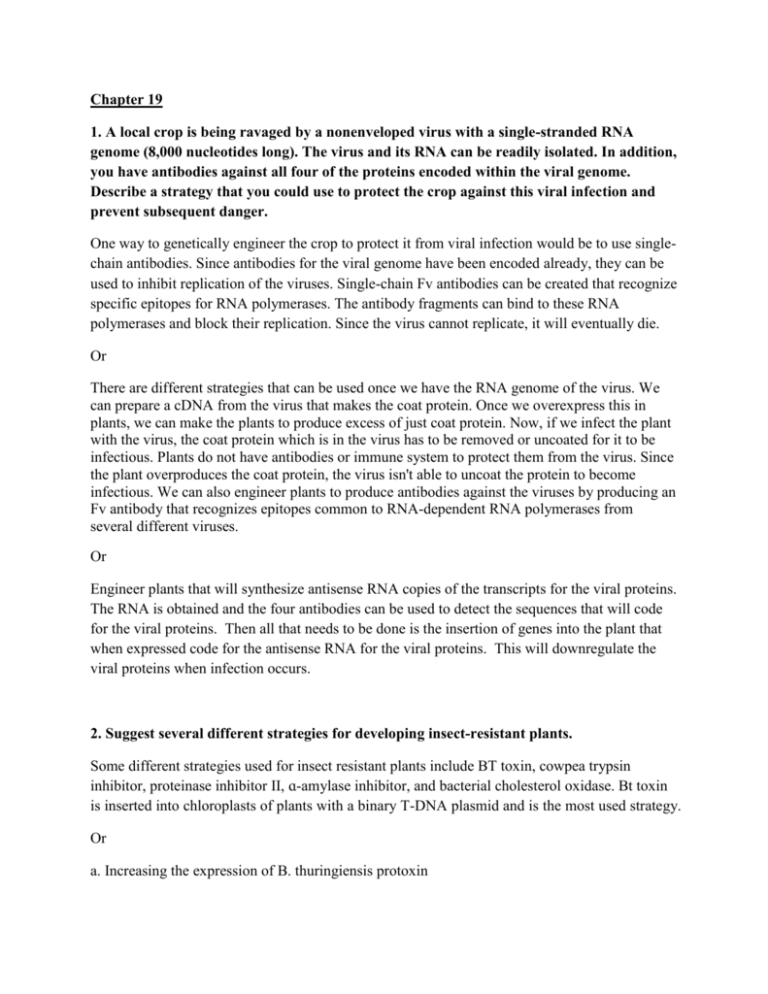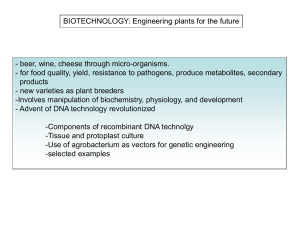Chapter 19 & 20 Homework
advertisement

Chapter 19 1. A local crop is being ravaged by a nonenveloped virus with a single-stranded RNA genome (8,000 nucleotides long). The virus and its RNA can be readily isolated. In addition, you have antibodies against all four of the proteins encoded within the viral genome. Describe a strategy that you could use to protect the crop against this viral infection and prevent subsequent danger. One way to genetically engineer the crop to protect it from viral infection would be to use singlechain antibodies. Since antibodies for the viral genome have been encoded already, they can be used to inhibit replication of the viruses. Single-chain Fv antibodies can be created that recognize specific epitopes for RNA polymerases. The antibody fragments can bind to these RNA polymerases and block their replication. Since the virus cannot replicate, it will eventually die. Or There are different strategies that can be used once we have the RNA genome of the virus. We can prepare a cDNA from the virus that makes the coat protein. Once we overexpress this in plants, we can make the plants to produce excess of just coat protein. Now, if we infect the plant with the virus, the coat protein which is in the virus has to be removed or uncoated for it to be infectious. Plants do not have antibodies or immune system to protect them from the virus. Since the plant overproduces the coat protein, the virus isn't able to uncoat the protein to become infectious. We can also engineer plants to produce antibodies against the viruses by producing an Fv antibody that recognizes epitopes common to RNA-dependent RNA polymerases from several different viruses. Or Engineer plants that will synthesize antisense RNA copies of the transcripts for the viral proteins. The RNA is obtained and the four antibodies can be used to detect the sequences that will code for the viral proteins. Then all that needs to be done is the insertion of genes into the plant that when expressed code for the antisense RNA for the viral proteins. This will downregulate the viral proteins when infection occurs. 2. Suggest several different strategies for developing insect-resistant plants. Some different strategies used for insect resistant plants include BT toxin, cowpea trypsin inhibitor, proteinase inhibitor II, ɑ-amylase inhibitor, and bacterial cholesterol oxidase. Bt toxin is inserted into chloroplasts of plants with a binary T-DNA plasmid and is the most used strategy. Or a. Increasing the expression of B. thuringiensis protoxin b. By protease inhibitors c. By alpha-amylase inhibitor d. By cholesterol oxidase e. By vegetative insecticidal toxins f. By using other proteins g. By RNA interference 4. How can RNAi be used to protect plants against damage from insect predation? By inserting double-stranded RNA into organisms, genes can be silenced. A cDNA can be obtained for an insect and double-stranded RNAs can be found that elicit RNAi and stop larval growth. The ATPase gene in particular has effective double-stranded RNAs. This gene can be inserted into Ti plasmid and can transform plants. 6. How can RNAi be used to protect plants against damage from plant viruses? RNAi can be used to silence the expression of an essential protein within an insect. The plant is engineered to produce the double stranded RNA for some gene that is very important to the insect. When the insect eats the plant it gets the dsRNA, dicer cleaves the dsRNA and the antisense strand is incorporated into the RISC complex. When this happens the insects RISC complex begins to degrade the mRNA for the important gene and the insect dies. 7. What general strategies can be employed in genetically engineering plants to be resistant to herbicides? In order to create herbicide resistant plants, there are four main ways that can be used. The first is to inhibit the uptake of the herbicide and make it so that the herbicide cannot even enter the plant. The second way is to overproduce a target protein that is herbicide sensitive. This allows the plant to function normally even with the herbicide. The third way is to reduce the binding of herbicide sensitive target proteins to the herbicide so that the herbicide has little effect on the plant. The fourth way is to allow plants to inactive the herbicide. One other way exists that includes adding fungal or bacterial genes to create a protein not sensitive to the herbicide but that can continue normal cell duties. 8. Suggest two different strategies for engineering plants that are resistant to the herbicide glyphosate. Why is this important? Since the herbicide glyphosate inhibits an enzyme EPSPS in the shikimate pathway, if we are able to transform a plant with EPSPS-encoding gene from glyphosate resistant strain of E. coli under the control of plant promoter and transcription termination polyadenylation sequences, the crop plant will remain unaffected by glyphosate treatment. This approach is termed as " Roundup ready" approach. Another method that can be used is the acetylation of glyphosate which is possible by the introduction of glyphosate N-acetyltrasferase gene and creating transgenic plants which are then tolerant of approximately six times the dose of glyphosate that killed the nontransformed plants. Since glyphosate is safe, cheap, effective and environmentally friendly due to its non toxic degradation in soil, if we are able to develop glyphosate resistant plants,it poses less harm to the environment, and also kills the unwanted weeds protecting the important crop plants. 11. How can plants be genetically engineered to be resistant to pathogenic bacteria? To engineer plants that are resistant to pathogenic bacteria I would create plants that overproduce salicylic acid. This can be done by transforming plants with the bacterial genes for isochorismate synthase and isochorismate pyruvate lyase which catalyze the production of salicylic acid. The salicylic acid stimulates the production of plant pathogenesis related proteins that help defend against bacterial and fungal pathogens. 15. Suggest several strategies that could be used to engineer plants that are resistant to growth inhibition by salt and by drought. 1. Engineer an increase in cellular accumulation of osmoprotectants 1.1 Introduction of betaine biosynthetic enzymes enables them to withstand water stress and/or high salinity 1.2 Increasing the trehalose concentration protects the plants against inhibition by high levels of salts in the soil 2. Overexpress the gene encoding Na+/H+ antiport protein which transports Na+ into the plant cell vacuole Specifically for creating drought resistant plants, we can: 1. Introduce genes encoding overproduction of various osmolytes like trehalose, proline, glycine betaine etc. 2. Introduce plant stress proteins like chaperones and heat shock proteins 3. Introduce reactive oxygen scavenging protein 4. Introduce hormone biosynthesis and catabolism proteins 5. Introduce transcription factors that turn on the synthesis of a host or other proteins 6. Introduce signaling proteins that activate the synthesis of other proteins 16. You have been asked by an avocado grower to find a way to genetically engineer his crop to prevent it from ripening during shipping. What experimental approaches would you consider? In order to prevent the avocado from ripening, the best approach would be to find the genes that are active in ripening the fruit and create an antisense or sense RNA producing versions of the gene to activate the process of RNA interference. The genes induced in the process of ripening produce enzymes like cellulase and polygalacturonase. If we are able to create transgenic plants with the introduction of sense or antisense RNA of the gene, we will be able to achieve the interference. Also, fruit ripening can be prevented by inhibiting the synthesis of ethylene. Creating transgenic plants which contain the RNA versions of ACC synthase, AA oxidase or S-adenosylmethionine synthetase which fall in the ethylene production pathway, will show lower levels of ethylene and hence, lower levels of ripening. Chapter 20 1. How can plants be genetically manipulated to produce flowers with unusual colors? To change the pigmentation of a flower one must use a strategy such as suppression (sense or antisense) in which RNAi prevents the expression of the enzyme necessary for producing the pigmentation. The resulting flowers will be white instead of colored. It is also possible to simply manipulate the genes for the enzymes in the anthocyanin biosynthesis pathway to produce different pigments. These compounds are responsible for producing most of the pigments observed in nature so manipulation of their structure can produce new pigments. 3. How can vitamins be overproduced in rice plants? Rice is deficient in several nutrients and vitamins, like vitamin A. We can therefore engineer rice to produce the vitamin A precursor provitamin A (β-carotene) by using agrobacterium mediated transformation to introduce the entire β-carotene biosynthesis pathway into rice. This process can be carried out by introducing phytoene synthase and phytoene desaturase genes without any selectable marker, and lycopene β-cyclase gene with a selectable marker in a separate construct. The expression levels of the genes were quite high and the engineered rice produced β-carotene, and mammals are able to synthesixe vitamin A from it.This transgenic rice producing β carotene has yellow or golden color and is known as the "golden rice". 9. How would you engineer an edible vaccine directed against V. cholera-caused diarrhea? Cholera is an infectious disease which is caused by the enterotoxin produced by the gram negative bacterium Vibrio cholerae. In order to produce an edible vaccine against V. cholerae, scientists transformed potato plants using A. tumefaciens with the cholera toxin subunit B gene. We know that the subunit B binds to an intestinal recptor and subunit A contains the toxin activity. These transgenic potatoes were boiled in water long enough to be edible by humans, and were fed to mice which were tested for antibodies against the subunit B protein and resistance against cholera. This test made it possible to acquire a significant level of protection against V. cholerae. 14. Why are plants an attractive host system, compared to bacteria and animal cells in culture, for the production of human therapeutic proteins? Plants are an attractive host system for the production of human therapeutic proteins because they can be grown extremely cheaply and with minimal amounts of labor compared to the amount of work necessary with animal cells. In addition, they are beneficial over bacterial systems because the proteins that are needed must be modified after translation to become effective and bacteria lack the machinery to accomplish these post-translational modifications. This makes plant cells very useful because they can produce high amounts of functional protein with low cost and maintenance. 17. How can the lignin content of trees be decreased? What is the benefit of this type of genetic manipulation? Decreasing the amount of lignin in a tree is important because lignin makes it more difficult to obtain cellulose to make pulp/paper. The lignin must be removed by chemically treating the wood and physically processing it for a long time period. This can be done by manipulating the oxidative polymerization of one of the alcohols that it is produced from. An antisense version of the gene for the enzyme that helps produce lignin can be added to the plant. This will cause downregulation of the lignin producing enzyme which will decrease the amount of lignin produced. 19. How can plants be genetically modified to increase their effectiveness in the phytoremediation of certain metals? Plants can be modified to more effectively phytoremediate by transforming plants with the YCF1 yeast gene. This gene detoxifies metals by transporting and sequestering them in vacuoles within the plant. It is also possible to engineer plants that can detoxify organic forms of mercury by incorporating genes from bacteria that will allow them to do it(merB and merA genes). It is also possible to incorporate nitroreductases, which are useful for degrading nitroaromatics such as TNT.








